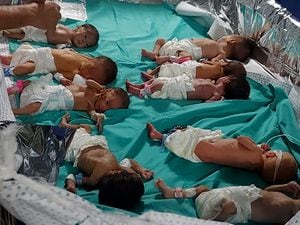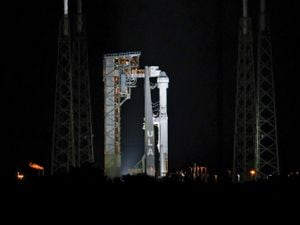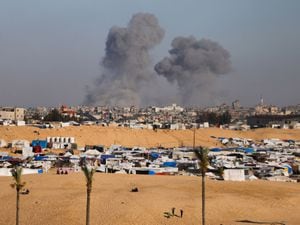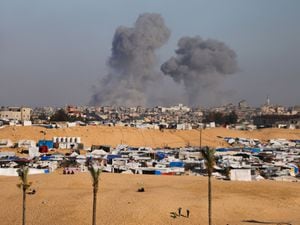Patients, including babies, stranded as battles rage around Gaza hospitals
The Israeli military has urged Palestinians to flee south on foot through what it calls safe corridors

Battles between Israel and Hamas around hospitals forced thousands of Palestinians to flee from some of the last perceived safe places in northern Gaza, stranding critically wounded patients and newborn babies with dwindling supplies and no electricity, health officials said on Monday.
The Israeli military has urged Palestinians to flee south on foot through what it calls safe corridors.
But its stated goal of separating civilians from Hamas militants has come at a heavy cost – more than two-thirds of Gaza’s 2.3 million people have fled their homes.
Thousands fled Gaza’s Shifa Hospital over the weekend as Israeli troops encircled it, and doctors said gunfire and explosions raged all around it on Monday.

Israeli troops appear to be only a short distance from the facility.
Hundreds of patients and displaced people remain in the hospital, officials say.
Shifa “is not functioning as a hospital any more”, World Health Organisation director-general Tedros Adhanom Ghebreyesus said.
US President Joe Biden said on Monday that Shifa “must be protected”.
“It is my hope and expectation that there will be less intrusive action,” Mr Biden said in the Oval Office.
After power went out for Shifa’s incubators days ago, the health ministry in Hamas-ruled Gaza released a photo on Monday it says shows about a dozen premature babies wrapped in blankets together on a bed to keep them at a proper temperature.
Otherwise “they immediately die”, said the health ministry’s director general, Medhat Abbas, who added that four of the babies had been delivered by Caesarean section after their mothers died.
The Red Cross was attempting on Monday to evacuate some 6,000 patients, staff and displaced people from a second hospital, Al-Quds, after it shut down for lack of fuel, but it said its convoy had to turn back because of shelling and fighting.

Both sides have seized on the plight of hospitals, particularly Shifa’s, as a symbol of the larger war, now in its sixth week.
The fighting was triggered by Hamas’ October 7 surprise attack into Israel, whose response has led to thousands of deaths, and much destruction, across Gaza.
For Palestinians, Shifa evokes the suffering of civilians.
For weeks, staff running low on supplies have performed surgery there on war-wounded patients, including children, without anaesthesia.
Up until days ago, tens of thousands of people driven from their homes by airstrikes lived in and around the complex, hoping it would be safe.
Israel says Hamas shields itself among civilians, and that the hospital, Gaza’s largest, is a prime example.
It says the militants have a command centre in and beneath the medical compound and released maps showing where it says they are located in the complex. But it has provided little evidence.
Both Hamas and Shifa hospital staff deny the Israeli allegations.

The Palestinians accuse Israel of firing recklessly toward hospitals, while Israel accuses Hamas of using the hospitals for cover.
On Monday, Israel released a video showing what it said was a militant with an RPG launcher entering Al-Quds hospital. An Israeli tank was stationed nearby.
Israeli officials recently released photos and footage showing what they described as gunmen firing from inside another hospital and the opening of tunnel next to it, though staff said it was the entrance to the facility’s underground fuel tank.
They also have shared footage of militants operating in residential neighbourhoods and positioning rockets and weapons near schools, hospitals and mosques.
International law gives hospitals special protections during war. But hospitals can lose those protections if combatants use them to hide fighters or store weapons, according to the International Committee of the Red Cross.
But there must be plenty of warning to allow evacuation of staff and patients, and if harm to civilians from an attack is disproportionate to the military objective, it is illegal under international law.
After the exodus of people from Shifa over the weekend, about 650 patients and 500 staff remain in the hospital, along with around 2,500 displaced Palestinians sheltering inside the complex, said Mohammed Zaqout, the director of hospitals in Gaza.
The health ministry said 32 patients, including three babies, have died since Shifa’s emergency generator ran out of fuel Saturday.
It said 36 babies, as well as other patients, are at risk of dying because life-saving equipment cannot function.
Goudat Samy al-Madhoun, a healthcare worker, said he was among about 50 patients, staff and displaced people who made it out of Shifa and to the south on Monday, including a woman who had been receiving kidney dialysis. He said those remaining in the hospital were mainly eating dates.
Al-Madhoun said Israeli forces fired on the group several times, wounding one man who had to be left behind. The dialysis patient’s son was detained at an Israeli checkpoint on the road south, he said.
The military said it placed 79 gallons of fuel several blocks from Shifa, but Hamas militants prevented staff from reaching it.
The health ministry disputed that, saying Israel refused its request that the Red Crescent bring them the fuel rather than staff venturing out for it. The fuel would have provided less than an hour of electricity, it said.
The US has pushed for temporary pauses to allow wider distribution of badly needed aid.
Israel has agreed only to daily windows during which civilians can flee northern Gaza along two main roads.
It continues to strike what it says are militant targets across the territory, often killing women and children.
Tens of thousands of people remain in the north.
Those who make it south face a host of other difficulties. UN-run shelters are overflowing, and the lack of fuel has paralysed water treatment systems, leaving taps dry and sending sewage into the streets. Israel has barred the import of fuel for generators.
As of last Friday, more than 11,000 Palestinians, two-thirds of them women and minors, have been killed since the war began, according to the health ministry in Gaza, which does not differentiate between civilian and militant deaths.
About 2,700 people have been reported missing.
At least 1,200 people have died on the Israeli side, mostly civilians killed in the initial Hamas attack.
Palestinian militants are holding nearly 240 hostages seized in the raid, including men, women, children and older adults. The military says 44 soldiers have been killed in ground operations in Gaza.
About 250,000 Israelis have evacuated from communities near Gaza, where Palestinian militants still fire barrages of rockets, and along the northern border, where Israel and Lebanon’s Hezbollah militant group repeatedly trade fire, including on Monday.





